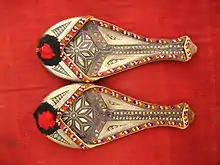Mojari
Mojari or Khussa or Saleem Shahi's is a style of handcrafted footwear produced in South Asia. They are traditionally made by artisans mostly using tanned leather. The uppers are made of one piece of leather or textile embroidered and embellished with brass nails, cowry shells, mirrors, bells and ceramic beads. Even the bonding from the upper to the sole is done by cotton thread that is not only eco-friendly but also enmeshes the leather fibers with great strength. Some product range also uses bright and ornate threads.[1]

As it evolved through the centuries and is being produced by individual artisans, products vary in designs and colours. It encapsules cultural diversity, local ethos and ethnicity.[2]
History
It is believed that one of the earliest examples of footwear worn on the Indian subcontinent is a sandal of wood, datable to circa 200 BC. During the 3rd and 4th Centuries in the Buddhist period, it was quite common to wear strapped sandals, and Indian kings wore sandals ornamented with precious jewels. Jain literature shows that leather was used for the making of shoes, which protected the toes from getting injured. Hides of cows, buffaloes, goats, sheep and other wild animals were used.[3]
The Mojari originated under the Mughal Empire, where it was decorated with colours, gems, and other ornaments. They are said to have been popularized under the Mughal King Saleem Shah and are often referred to as Saleem Shahis as a result.[4] They are also commonly worn with Shalwar Kameez. Although leather shoes have been worn for over 5,000 years by various civilizations, they should not be confused with Mojaris, because Mojaris are unique in their ornamental style, shape, and appearance.
See also
References
- Jutta Jain-Neubauer; Bata Shoe Museum (2000). Feet & footwear in Indian culture. Mapin Publishing Pvt. Ltd. pp. 126, 175. ISBN 81-85822-69-7.
- Ishraqi Designs. "Khussa shoes-symbol of the traditional culture of sindh/".
- Feet and Footwear in Indian Culture, Jutta Jain-Neubauer, Bata Shoe Museum Foundation, Toronto, Canada, in association with Mapin Publishing Pvt. Ltd., p.171.
- Shazia Hasan, The shoe fits, Dawn